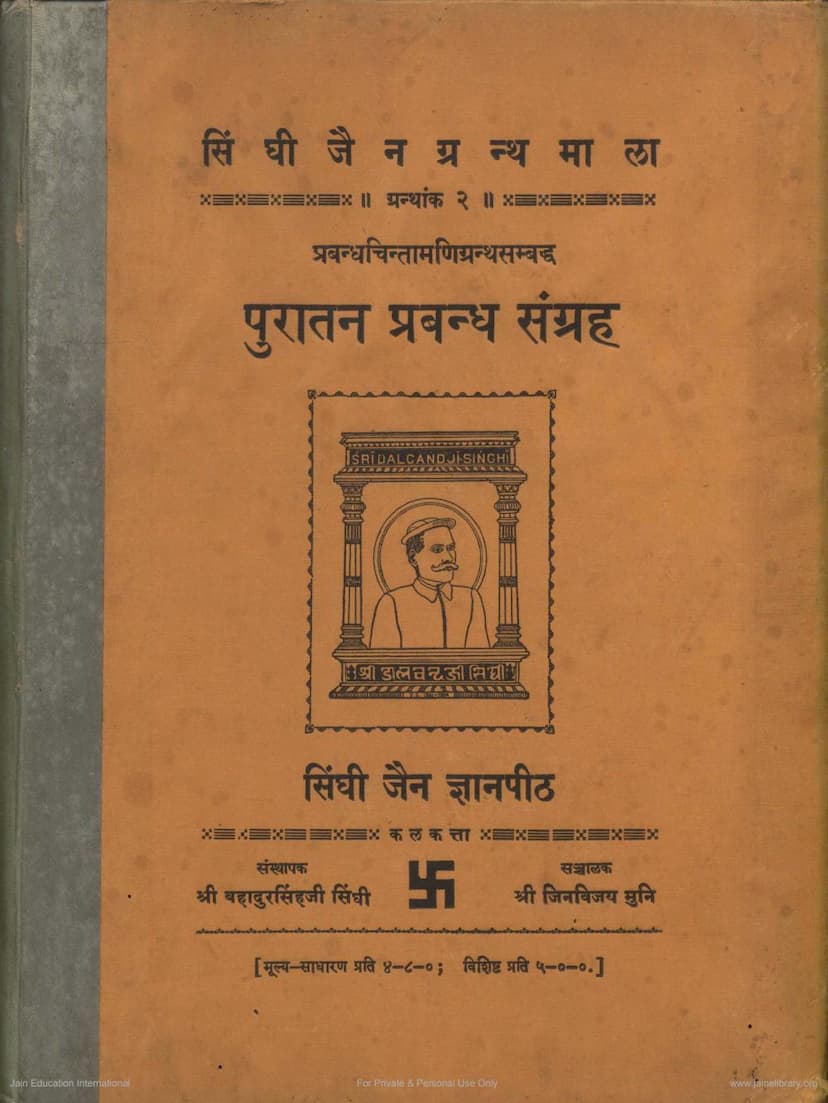Puratana Prabandha Sangraha
Added to library: September 2, 2025

Summary
This is a summary of the Jain text "Puratana Prabandha Sangraha" (पुरातन प्रबन्ध संग्रह), compiled by Jinavijaya Muni and published by the Singhi Jaina Jnanapitha, Calcutta, under the Singhi Jaina Granthamala series, Number 2. The work is a collection of ancient "prabandhas" (narratives or accounts) that are related to or similar in theme to the renowned "Prabandhachintamani" (प्रबन्धचिन्तामणि) by Merutunga Suri.
Overall Purpose and Content:
The "Puratana Prabandha Sangraha" aims to supplement the "Prabandhachintamani" by bringing together various ancient narratives that share similarities in subject matter, style, or historical context. These prabandhas often deal with the lives of kings, scholars, ministers, and other notable figures from Jain history and tradition, detailing their deeds, virtues, and the events of their times. The collection is based on several old manuscripts, identified by the letters P, B, BR, G, and Ps., each representing a different source collection.
Structure and Scheme of the Larger Work:
The "Puratana Prabandha Sangraha" is presented as the second part of a larger planned work dedicated to the "Prabandhachintamani." The overall scheme for the "Prabandhachintamani" work was envisioned in five parts:
- Part I: A critical edition of the original "Prabandhachintamani" text in Sanskrit, with variant readings, an appendix, indices of verses and proper names, and an introduction with plates describing the manuscripts used.
- Part II: The "Puratana Prabandha Sangraha" itself – a collection of prabandhas similar to those in the "Prabandhachintamani," with indices of verses and proper names, and an introduction describing the manuscripts.
- Part III: A complete Hindi translation of Parts I and II.
- Part IV: A collection of contemporary epigraphical records (inscriptions, copper plates, colophons) related to the persons mentioned in the "Prabandhachintamani," along with detailed commentary and plates.
- Part V: An elaborate general introduction to the entire work, surveying the historical, geographical, social, political, and religious conditions of the period, with illustrations.
Key Features of the "Puratana Prabandha Sangraha" (Part II):
- Collection of Prabandhas: It contains numerous ancient prabandhas that are thematically or historically linked to the "Prabandhachintamani." Some of these are found in separate manuscript collections, while others are related to works like the "Prabandhakosha" by Rajasekhara Suri.
- Manuscript Basis: The compiler, Jinavijaya Muni, meticulously collected these prabandhas from five primary manuscript sources, denoted as P (Patana manuscript), B (Bhavanagar manuscript), BR (Bhandarkar Oriental Research Institute - likely a reference to manuscripts available there or the institute's own collections, though the text mentions BR for some specific prabandhas), G (Gandhinagar manuscript), and Ps (Patan Jain Agamik Granthagar manuscript).
- Editorial Approach: The prabandhas are presented in an order that generally follows the sequence found in the "Prabandhachintamani" for easier comparison. The collection includes indices of proper names and verses. Where variant readings were found in the source manuscripts, they are noted in footnotes or incorporated with notations.
- Introductory Matter: The volume begins with a "Prastavik Vaktavya" (Preliminary Statement) and detailed "Prastavik Tippani Suchita Parishishta Sangraha" (Introductory Notes and Supplementary Collection), which provide information about the manuscripts used, the nature of the collected prabandhas, their potential origins, and the editorial process.
- Specific Prabandha Collections: The introductory notes detail the characteristics of each manuscript collection (P, B, BR, G, Ps.), including their condition, estimated age, and notable contents.
- Historical and Literary Significance: The prabandhas themselves offer valuable insights into the history, culture, religious practices, and social customs of ancient India, particularly within the Jain tradition. They cover a wide range of historical figures and events.
- Inclusion of Plates: The work includes reproductions of manuscript pages to provide readers with a visual understanding of the original texts.
- Praise for the Founders: The introductory sections also contain "Prashastis" (eulogies) for the founders of the Singhi Jaina Granthamala, Sri Dalchandji Singhi and Sri Bahadur Singhji Singhi, highlighting their dedication to preserving and publishing Jain literature.
Key Themes and Figures Covered (based on the extensive table of contents and introductory notes):
The prabandhas in this collection cover a vast array of historical figures and events, often overlapping with or providing additional context to the narratives in the "Prabandhachintamani." Some of the prominent figures and themes include:
- Vikramarka and Related Prabandhas: A significant portion of the collection deals with the legendary king Vikramarka, his exploits, and stories related to his reign.
- Kings and Rulers: Various rulers like Vanaraja, Mulraj, Jayasimha, Siddharaja, Siddharaja Jayasimha, Kumarapala, Ajyapala, Bhoja, Bhoja-Gängeya, Vikramaditya, Bhojadeva-Subhadra, Bhoja-Dhara, Munja, Vikramaditya Satva, Bhoja-Gangaeya, Vidisha, Daharadhwansa, Bhoja-Gangaeya, Bhoja Deva-Subhadra, Dharadhwansa, Siddharaja Audarya, Bhoja-Gangeya, Munjraj, Bhoja Deva-Subhadra, Dharaadhwansa, Siddharaja Audarya, etc. are covered.
- Ministers and Scholars: Prominent ministers like Madana-Brahma, Jayasimha Deva's minister Santu, Yashovira, Udāyana, Bahada Deva, Ambaḍa, and scholars like Padmalipati Suri, Abhayadeva Suri, Hemachandra Suri, Vagbhata Vaidya, Magha Pandit, Haribhadra Suri, Siddharsu, and others are featured.
- Religious and Historical Figures: Accounts of various Jain Tirthas (holy sites) like Arasanemi Chaitya, Phalavardhika Tirtha, Girnar, Shatrunjaya, Raivataka, and the activities of influential monks and religious patrons are included.
- Social and Cultural Aspects: The prabandhas indirectly shed light on social customs, economic activities, and the patronage of arts and literature during different periods.
Significance:
The "Puratana Prabandha Sangraha" is a crucial work for scholars of Jainism, Indian history, and literature. It provides access to a wealth of primary source material in the form of ancient narratives, many of which might not be readily available otherwise. The critical editing and compilation by Jinavijaya Muni, a renowned scholar, enhance its value for research and understanding of a specific genre of historical and literary writing in Jain tradition. The detailed introductory and appendix sections are invaluable for contextualizing the prabandhas and understanding the manuscript traditions.